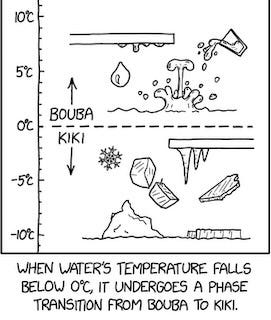Our favorite things change. That feels like one of those, “duh…” kind of statements. But, like a lot of “duh…” statements there’s a lot more going on under the hood than is immediately obvious.
Take the above example illustrated by xkcd creator Randall Munroe. He uses the well-known law of physics about the transition of water from liquid to solid at O°C and adds to it a linguistic element that turns the phenomenon into a metaphor. It’s an example of what Malcolm Gladwell famously called, “the tipping point.” the moment that makes the difference between one thing and another.
Most people are unaware that studying this phenomenon is deeply ingrained in the history of psychology. Wilhelm Wundt founded the first “official” psychological laboratory at the University of Leipzig in 1879. Interestingly, he studied the things that would make psychology look most like physics: perceptual thresholds that could be precisely measured. For example, Wundt would ask blindfolded subjects holding stacks of 1/32nd of an ounce weights in each hand to determine which pile weighed less as assistants removed one weight at a time from one hand. As soon as a subject felt one stack was lighter, the experimenter had found the “just noticeable difference” for perceiving relative weights between two hands, the tipping point.
Are you familiar with the “bouba/kiki effect?” It’s a demonstration of how language can express ideas through sound rather than conceptually. Psychology study participants were asked which of two shapes was named “bouba” and which one, “kiki,” in a foreign language.
Here are the shapes. Quick: which one is bouba?
Turns out a significant number of people guess the shape on the left is called “kiki” and the one on the right “bouba.” This is different from a tipping point study in that subjects are asked to compare the two shapes, not to evaluate the moment when one became the other.
In Munroe’s example the change from bouba/water to kiki/ice is definitive: at 1°C it’s water, at 0°C it’s ice. This phenomenon is what chemists and physicists call a “phase change.” Nice and clean.
But a lot is happening in the water as the temperature moves from, say 10°C to 1°C. It’s just that what’s happening isn’t obvious; it hasn’t yet reached that bouba/kiki moment.
Well, what about us? How much of what changes in our lives is as clear as the liquid/solid transition of water?
Evolutionary biologists and anthropologists studying culture employ an analogous notion when describing culture change: “punctuated equilibrium.”
The idea holds that cultural change results from individuals copying ideas, practices and/or behaviors from others. Copying, or imitating, is facilitated by technology that enhances either the speed at which alternative ideas or practices appear, the breadth of available options, or both. The increased number of possible vectors (i.e., the range of directions for new possibilities), as well as the potential volume and velocity of those options, is one explanation of why we feel as if change is speeding up. We’ve internalized a different standard for the “life span” of objects, practices, or ideas. The world is more transitory for us than it was for our predecessors.
We now speak casually about changes “being in the wind.” Or about “vibe shifts;” or, things being “in vogue.” More generally, we refer to “the Zeitgeist” to provide a conceptual umbrella for the events that take place in a certain timeframe. These phrases and the psychological processes they emerge from are clues to a relatively recent expectation of cultural dynamism.
Ever since the mid-20th century, Americans have settled into cyclical ways of thinking about the year. While nature’s seasons have governed the rhythms of cultures for thousands of years, commercial seasons have been overlayed on nature’s for much of the last 75 or so years. Expecting new variations in everything from color schemes to entertainment offerings, to sports competitions, to automobile models has now become “baked into” the American psyche. We now routinely anticipate/expect new/improved versions of things.
Even ourselves. Every January millions (billions?) of us resolve to re-make ourselves into something we dream of being: trimmer, more well-read, kinder.
This year, we are about to cross what many are anticipating as a bouba/kiki moment with the second inauguration of Donald Trump as president. Some (let’s call them “the boubas”) see this moment as a chance to undo decades (centuries?) of social structures that have led to the decline of The American Experiment. Finally, America will be great, again.
Others (“the kikis”) fear the changes that the new administration promised during the election campaign will signal a turning toward the worst examples of authoritarianism since the days leading up to World War II.
Both boubas and kikis are likely to perceive events (even the same events) in ways that confirm pre-existing beliefs about the vibe/Zeitgeist. We are primed to see that which we expect to see.
Here’s the difference. Water can’t help going from bouba to kiki at 0°C; it is in water’s nature. We can help going from one state to another on January 20th. How? It’s a matter of awareness. If I honestly evaluate my current bouba/kiki expectations about the future, I am forearmed against having those expectations color my perception of every single event or decision. It will be very hard for each of us not to automatically categorize every event under the current banner; the cultural forces around us will encourage us to do so daily.
But remember, unlike water, your psychological state is not the result of a law of nature. You have some control over the meaning of the events you are going to experience and your reactions to them. Knowing your “pre-existing conditions” going in and taking them into account when reacting to the cultural effects of the vibe moments that are about to be turned up to 11 is a key to maintaining a healthy equilibrium! Getting tossed around by every single thing that happens every day is not a healthy/sustainable point of view in a change-heavy world.
I’m going to do my best to do that, knowing that my pre-existing “kiki-ness” is going to be a challenging opponent every step of the way!
Tom Guarriello is a psychologist, consultant, and founding faculty member of the Masters in Branding program at New York’s School of Visual Arts. He’s spent over a decade teaching psychology-based courses like The Meaning of Branded Objects, as well as leading Honors and Thesis projects. He’s spearheaded two podcasts, BrandBox and RoboPsych, the accompanying podcast for his eponymous website on the psychology of human-robot interaction. This essay was originally posted on Guarriello’s Substack, My Favorite Things.
The post My Favorite Things: Change, Slowly Then All at Once appeared first on PRINT Magazine.

